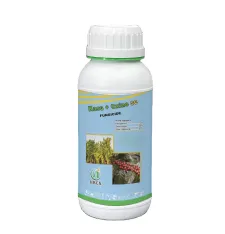
Jul . 21, 2025 14:06 Back to list
Using Fungicide to Protecting Your Crops from Fungal Diseases
Fungal diseases pose one of the greatest threats to agricultural productivity worldwide. Fromdevastating tomato blights to soil-borne pathogens, these microscopic invaders can decimate crops and ruin harvests. This comprehensive guide explores three powerful fungicide solutions: specialized fungicide for tomatoes, versatile systemic fungicide formulations, and the highly effective metalaxyl fungicide. Whether you're growing vegetables, fruits, or field crops, understanding these protective treatments will help you maintain healthy plants and maximize yields.

Fungicide for Tomatoes: Essential Protection Against Common Blights
Tomatoes rank among the most fungus-prone crops, with diseases like early blight (Alternaria solani), late blight (Phytophthora infestans), and powdery mildew causing significant losses. A proper fungicide for tomatoes program can mean the difference between a bumper crop and complete failure.
Key Features of Tomato-Specific Fungicides:
Dual-action protection (preventative and curative)
Rainfast formulations that withstand irrigation
Low phytotoxicity for sensitive tomato plants
Resistance management properties
Application Guidelines:
Seedlings: Begin applications 2-3 weeks after transplanting
Pre-flowering: Apply before fruit set for maximum protection
Fruit development: Maintain 7-14 day intervals during humid periods
Harvest interval: Follow product-specific guidelines (typically 0-3 days)
Common Tomato Fungal Diseases Controlled:
Early blight (target spot)
Late blight (potato/tomato blight)
Septoria leaf spot
Anthracnose fruit rot
Powdery mildew
Systemic Fungicide: Advanced Protection From the Inside Out
Unlike contact fungicides that remain on plant surfaces, systemic fungicide products are absorbed and distributed throughout the plant's vascular system, offering superior, long-lasting protection.
Advantages of Systemic Formulations:
✔ Complete plant protection (including new growth)
✔ Reduced application frequency
✔ Effective against root and soil-borne diseases
✔ Weather-independent performance
✔ Can stop existing infections
Best Uses for Systemic Fungicides:
Fruit trees: Apple scab, peach leaf curl
Vine crops: Downy mildew, gummy stem blight
Root vegetables: Fusarium, Rhizoctonia
Ornamentals: Rose black spot, rusts
Application Methods:
Soil drench for root zone protection
Trunk injection for tree diseases
Foliar spray for immediate uptake
Seed treatment for early protection
Metalaxyl Fungicide: Specialized Oomycete Control
Metalaxyl fungicide belongs to the phenylamide group and remains one of the most effective solutions against oomycete pathogens like Phytophthora and Pythium species.
Key Benefits:
Excellent curative and preventative action
Specific mode of action against water molds
Long residual activity in plants
Compatible with many other fungicides
Primary Target Pathogens:
Phytophthora capsici (peppers, cucurbits)
Pythium spp. (damping-off diseases)
Downy mildews (grapes, lettuce)
Late blight (tomatoes, potatoes)
Application Recommendations:
|
Crop |
Disease |
Rate (per acre) |
Interval |
|
Potatoes |
Late blight |
0.5-1.0 lb |
7-10 days |
|
Tomatoes |
Phytophthora root rot |
1.0-2.0 qt |
14-21 days |
|
Cucurbits |
Downy mildew |
0.75-1.5 pt |
10-14 days |
|
Soybeans |
Phytophthora rot |
1-2 qt/100 lb seed |
Seed treatment |
Integrated Fungicide Strategies for Different Crops
Successful disease management requires tailored approaches for various agricultural systems:
Vegetable Crops:
Tomatoes: Rotate fungicide for tomatoes with different FRAC groups
Potatoes: Combine metalaxyl fungicide with protectants for late blight
Leafy greens: Use systemic products during rapid growth phases
Fruit Production:
Grapes: Alternate systemic and contact fungicides
Strawberries: Begin systemic fungicide applications before flowering
Citrus: Focus on copper combinations for fungal and bacterial control
Field Crops:
Corn: Seed treatments with metalaxyl fungicide for seedling protection
Wheat: Early season systemic applications for rust prevention
Soybeans: Foliar systemics during pod development
FAQs About Fungicides
1. What makes a good fungicide for tomatoes different from general-purpose products?
Specialized fungicide for tomatoes is formulated to address the specific disease complex affecting tomatoes while being gentle on the sensitive foliage and fruit. They often combine multiple active ingredients to control both foliar and soil-borne pathogens.
2. How long does systemic fungicide protection last compared to contact types?
While contact fungicides typically protect for 5-7 days, a quality systemic fungicide can provide 14-21 days of protection, depending on environmental conditions and disease pressure.
3. Why is metalaxyl fungicide particularly effective against water mold diseases?
Metalaxyl fungicide specifically inhibits RNA polymerase in oomycetes, a mode of action that doesn't affect true fungi. This targeted approach makes it exceptionally effective against Phytophthora and Pythium species.
4. Can these fungicides be mixed with other crop protection products?
Most modern fungicide for tomatoes, systemic fungicide, and metalaxyl fungicide formulations are compatible with common insecticides and fertilizers, but always conduct a jar test and check labels for specific restrictions.
5. What's the best resistance management strategy when using these fungicides?
Rotate between different FRAC code fungicides, mix systemic with contact products, and integrate cultural controls. For metalaxyl fungicide, always use in combination with a protectant fungicide to delay resistance development.
-
Tembotrione Mode of Action in Weed Control
NewsJul.21,2025
-
Safety Guidelines for Handling Atrazine in Farming
NewsJul.21,2025
-
Mesotrione Residue Management in Crops
NewsJul.21,2025
-
How Topramezone Controls Resistant Weed Species
NewsJul.21,2025
-
How to Properly Handle Glufosinate Ammonium
NewsJul.21,2025
-
Best Practices for Applying 2 4d Herbicide
NewsJul.21,2025
